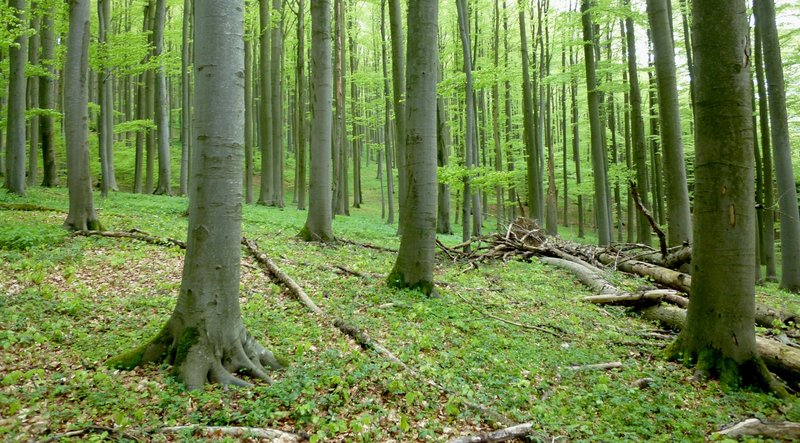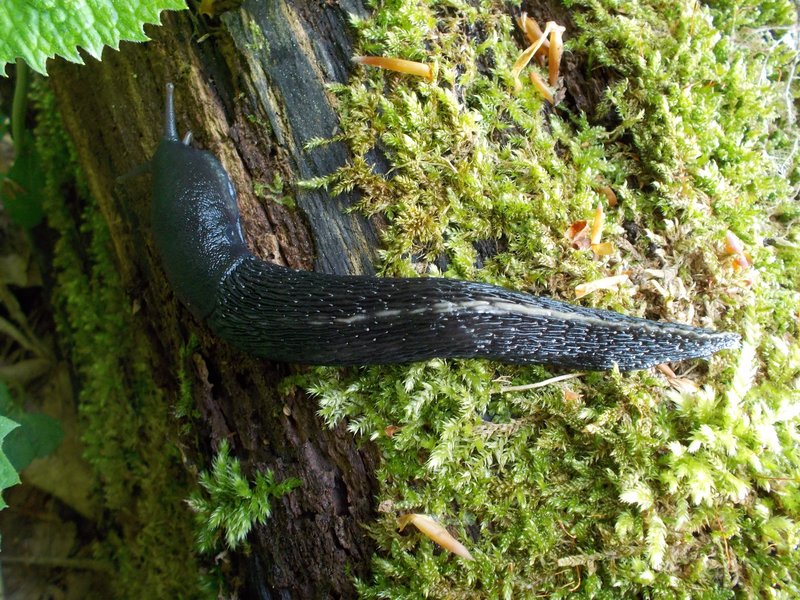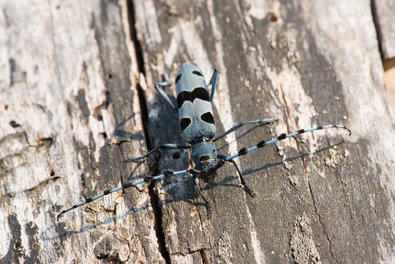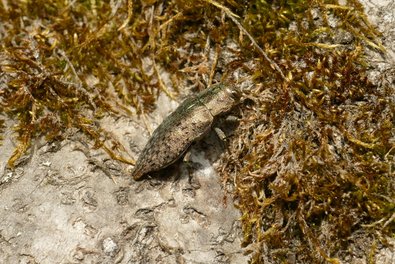For a long time, beech forests were considered so species-poor that this predicate even became part of the scientific name usually given to them in vegetation science (“species-poor beech forests”). There has however been a gradual and now complete paradigm change in the way we view beech forests, so that they are now in fact considered to be particularly species-rich, and important for the conservation of native biodiversity. But is this really justified? This article critically examines this view, by examining the species diversity and “uniqueness” of the species in our beech forests in comparison with other forest habitats.
If we consider all species groups, beech forests are at least not extremely poor in species, although the assessment of their species richness is often based on decidedly provisional, very old results. In this article, we focus specifically on those species that are dependent on beech forests, because all other species can also be protected in other forest types, and thus cannot be used to justify special importance being given to the protection of beech forests.
Soil and litter dwellers
The species-rich, well-studied ground beetles species group that colonise the litter layer are good indicator species, because many of the species are closely tied to the site and the climate in the stand. This species group is also rich throughout Europe in relict species with low dispersal rates. Although some species can regularly be found in beech forests, these tend to be below average in terms of species diversity in comparison with other forest habitats in central Europe. There is no species here that is strictly bound to beech forests, even in the canopy. Even those species reputed in some regions of Europe to prefer beech forests are nevertheless also widespread in other forest types, at least in most regions. In regions where they have survived the ice age, on the other hand, beech forests are home to a number of beech forest specialists with a low spreading rate, including some endemics.
Also in the case of molluscs, which tend to be poorly represented in terms of the number of species in beech forests here, there are no species at all that are bound to beech forests. This is different to other regions in Europe, where molluscs have a greater species diversity and include some beech specialists.
At least in the case of some species groups of the soil mesofauna, beech forests are species-rich, and also more species-rich than some other forest types. Moss mites (Oribatidae) in particular may for example show a greater species diversity in pure beech stands with their poorly decomposing litter than in mixed stands and under ash or lime. This is because moss mites tend to be specialists of types of organic matter that decay more slowly, whereas other decomposer groups such as Collembola dominate under more favourable conditions. However, there are no real beech forest specialists among the moss mite species.
Deadwood-dwelling beetles
In beech forests with lots of deadwood, the occurrence of xylobiont beetles can certainly be species-rich, albeit with a clear decrease in the number of species from southern to northern Europe. A comprehensive evaluation of data on several xylobiont beetles that are bound to primeval forest structures, i.e. beetles with particular requirements, revealed that there are no species in western central Europe that are dependent on beech trees or beech forests. The few species that are considered partly to be beech specialists, such as the Alpine longhorn beetle (Rosalia alpina) or the Berlin jewel beetle (Dicerca berolinensis), also occur on other tree species.
For the xylobiont beetles dependent on primeval forest structures and found in the Hochspessart region, beech is far less important than sessile oak, because none of the "primeval forest relict species" found there lives exclusively on beech. However, if we define beech forests as all stands in which more than 50 % of the trees are beech, two thirds of Europe's xylobiont beetle species can at least occasionally be found in this habitat. It should be emphasised that such high proportions of admixed tree species on normal sites can only be achieved through intensive tending measures and management. In beech forests managed to be “close to nature”, or beech forests even left to their own devices, the proportion of admixed tree species on normal sites would be significantly below 5% in most regions, and in some cases even below 3%.
A comparison with naturally growing stands, i.e. stands that are usually completely dominated by beech, is sobering. Many xylobiont species are dependent on certain flowering plants when it comes to maturation feeding. These must be in the vicinity of the tree on which they hatch. If there are only “trace elements” of admixed tree species, and there is a lack of sunlight and flowering plants, there is no basis for the occurrence of many species.
Canopy dwellers
As a host tree for leaf-eating and leaf-dwelling animal species, beech tends to be below average in terms of species numbers. This is true generally - and also for most species groups. The authors Bußler and Goßner name 275 phytophagous species and 44 specialists for the genus Fagus, although these values should probably be corrected downwards. In combination with the fact that natural beech forests have below average proportions of admixed tree species, this means that beech forests tend to be below average in terms of species diversity.
Bastian et al. nevertheless name 62 butterfly species (excluding small butterflies) as species that have at least occasionally been found on beech in Baden-Württemberg. The number of species of butterflies that occur in beech forests is however significantly lower than the number found on oak, birch, willow and poplar. In the course of intensive butterfly surveys in an area of beech forest that was initially a natural forest reserve and had thereby been unused for half a century, in today’s Eifel National Park, Wittland et al. found only a relatively small proportion of species characteristic of beech forests, and of endangered or rare species.
As they tend to be quite cool and shady, beech forests are not a preferred habitat for most butterfly species. This does not however apply to moths and small butterflies. Some small butterflies are in fact more or less completely bound to beech trees. Nevertheless, beech forests in areas that have long been beech forests are richer in monophagous species, and most significantly also home to endemic species.
For some species groups of the tree canopy, such as cicadas, beech forests are almost completely unsuitable as a habitat. Only five cicada species occur on beech trees, none of which is a beech forest specialist. This is very different to the situation in oak forests, for example. There is not a single species of plant lice (Psylloidea) that occurs on beech, either. Net-winged insects (Neuoptera) are also rather poorly represented in beech forests, and their diversity decreases significantly when the admixed tree species disappear as a result of their competitive inferiority to beech. The diversity of true bug species in the beech forests of the Hainich National Park is dependent on a mixture of tree species that can only arise through the silvicultural promotion of admixture tree species; it is considerably lower in stands extremely dominated by beech.
As with many other genera, species specialising strictly on beech are found above all among the other leaf-colonisers. These include the beech gall midge (Mikiola fagi), the hairy beech gall midge fly (Hartigiola annulipes) or also the woolly beech aphid (Phyllaphis fagi) and the beech leaf-miner beetle (Orchestes fagi). The list of beech-colonising phytophagous beetles is short in comparison with their wide distribution. Not a single indigenous leaf beetle is a beech specialist.
Vertebrates, fungi and plants
No vertebrates are beech forest-specialists, although some species certainly favour holes in beech trees, as beech trunks are often long, branch-free, and relatively smooth, thus offering predators little opportunity to climb. This category includes the black woodpecker (Dryocopus martius), a master builder of these cavities, as well as the stock dove (Columba oenas) and the edible dormouse (Glis glis), both discerning users of the black woodpecker’s tree cavities.
Fungi are one group that have taken over beech forests for themselves with many different species. According to surveys from Bavarian natural forest reserves, however, only 20 species have a close preference for beech forests - including seven species which are very closely tied to beech. These are mainly species among the first decomposers of branches and twigs. Overall, only a few fungi are beech-bound specialists. This is because of the “low hurdle” that beech with no heartwood presents for those species that want to colonise it.
There is no plant species that is strictly bound to beech forests. Mosses in particular are largely absent from the ground vegetation, because they do not tolerate the annual cover of poorly decomposable litter. Thick layers of leaf litter over mouldy humus and low levels of light reduce the possibilities for both basophilic and light-loving species. Mosses and lichens of the canopy are mainly found in older stand stages, when the beech bark becomes somewhat rougher. There are no beech specialists among them, either.
Conclusions
To summarise, it is not a particularly large number, but in fact a particularly small number of species that are specifically adapted to beech forests or strictly dependent on them. Our beech forests are thus extremely low in numbers of faithful species, i.e. beech forest specialists. This is different in other parts of Europe, where beech forests have survived continuously since before the ice ages. From this point of view, it is simply wrong to want to assign a special position or a particularly high responsibility to beech forests in central European forest nature conservation, just because they originally had a very extensive range and we happen to have a relatively large share of their European area. This is especially the case given the not undisputed role man has played in the spread of common beech and in its dominance in central Europe.
A mind game should clarify the consequence of this view. Let us imagine we are faced with the task of loading a "Noah's Ark 2.0" with five shipping containers, containing sample sections of the five most typical indigenous forest communities, which should cover the entire diversity of indigenous forest species. The selection includes riparian and marsh forests, as well as bog forests, ravine forests, oak forests, high altitude coniferous forests, and finally beech forests. For reasons of space, we have to leave one container behind in our game, but we do not want to sacrifice any species in the process. The container we would leave behind on the dock would be the one with the beech forest, because unlike all of the other forest communities, it is not home to any “unique species”.
The decision would be similar if we considered the overall number of species. If you take away the special sites in the forests, such as wetland habitats and rocks, there are also not really very many individual species in our beech forests. Beech forests are not extremely species-poor, at least for the vast majority of species groups, but nor are they by any means above average in terms of species diversity, again except for a few species groups. Most other broadleaf forest types, such as oak and riparian forests, are not only richer in endangered species and specialists, but also considerably richer in species overall.
This representation is certainly not intended to diminish the nature conservation value of beech forests. Numerous species are regularly found in beech forests, including, with varying regularity, rare and endangered species, as well as species which we have a duty to protect. However, all of these species could survive in Germany even if there were no beech forests here.
This is a purely hypothetical situation, and one which no one is advocating. This mind game and article are however intended to rectify the imbalance that has arisen in popular discourse in recent years. It is very misleading to refer to our beech forests as the “Amazon forest of central Europe”.
The real Amazon forest is home to countless species that only exist there. It is currently subject to severe decline and the irretrievable extinction on a day-to-day basis of countless species through overexploitation - overexploitation which often also helps to satisfy our needs and demands in central Europe for cheap beef, animal feed and “biofuel”. It is thus quite simply factually incorrect to call our beech forests in central Europe the "Amazon forest of Central Europe", or to put their importance and situation on the same level as those of the Amazon forest.
It is nevertheless necessary to protect beech forests, and we do protect them, quite rightly, in all possible protection categories, from protected landscape to national park. They must be allowed to grow old on a sufficient area there; and this is the case. We must find the necessary patience for this lengthy ecological process in the forest, which is only just beginning in many recently established natural forest reserves and national parks. Over a considerable area, we also need the helping hand of a forest manager, however, intervening with targeted measures that ensure diversity, allow more light in the forest, and promote secondary tree species and the understorey. Only with this intervention can a high number of species groups thrive with great species diversity on beech and above all in mixed beech forests.
In the context of climate change, it is particularly important to have a network that allows forest species, many with a low spreading rate, to migrate. Natura 2000 is one such network. Our beech forest habitat types are quite rightly all included in Annex I of the Habitats Directive. Also quite rightly, and unlike bog, ravine and softwood alluvial forests, they are not classed as priority habitat types.
In many regions, beech forests are of great value as near-natural habitats. These often provide important refuges for many deciduous forest dwellers, especially in conifer-dominated or very sparsely forested landscapes, and should be preserved at all costs. If we exaggerate the biodiversity of beech forests as an argument, we run the risk of making “the emperor’s new clothes” the subject of the discourse. Although rare and endangered species can be found in beech forests - those that live in deadwood structures, for example - this also applies to all other forest types in central Europe - with the difference that these forest types also have various specialists that depend on them. Any artificial exaggeration of the importance of a forest type leads in relative terms to a diminution of the importance of other in fact more endangered assets and their relevant interdependencies. In the context of climate change, a habitat network of diverse, well-developed forest habitats is thus the absolute priority in future for the preservation of biodiversity, especially in forests.
At a glance
- The beech forests of Central Europe have very few so-called faithful species that are strictly bound to beech trees or beech forests; it is the forest type of Central Europe with the lowest degree of species specialisation.
- The overall species diversity in beech forests is also not above average.
- The widespread exaggeration of the importance of beech forests for biodiversity is not justified.





